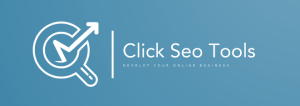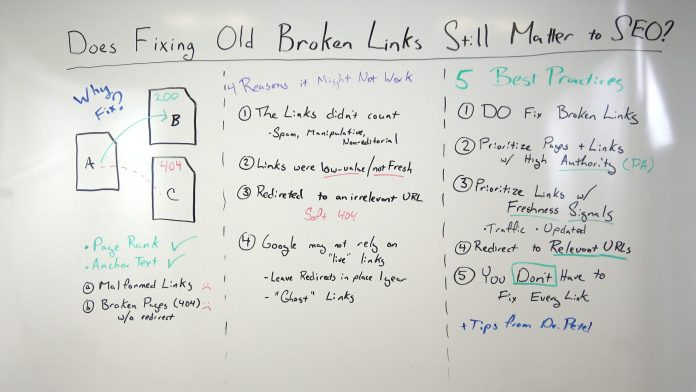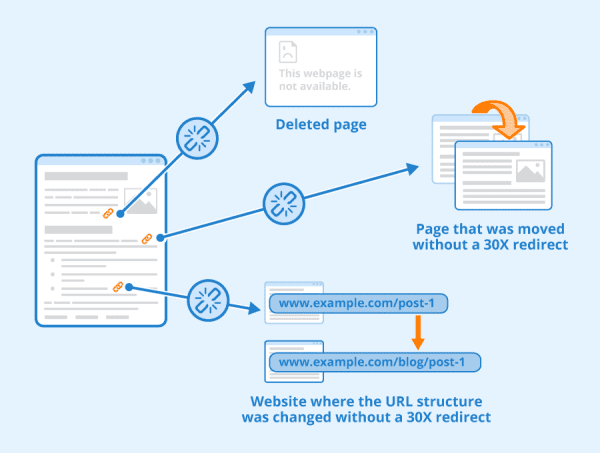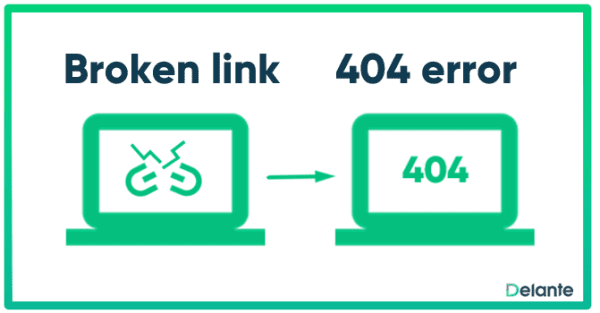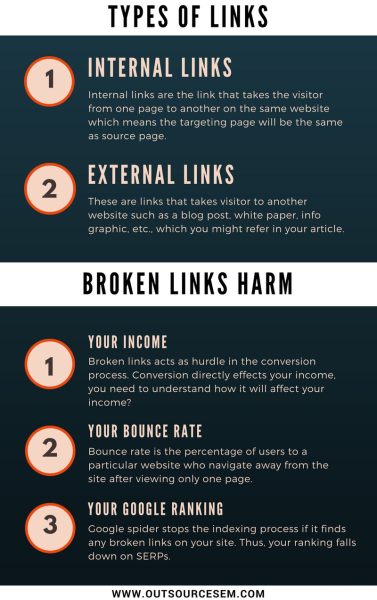Picture this: You’re browsing a website, clicking on various links to explore its content, when suddenly you’re faced with a dead end – a broken link. Frustrating, right? Well, not only is it annoying for users like you, but it also has a significant impact on SEO. A broken link is a hyperlink that no longer works, leading to an error page that signals the end of the road. In the world of search engine optimization (SEO), these broken links can harm your website’s rankings and overall performance. So, let’s dive into the ins and outs of broken links and understand how they can affect your SEO efforts.
This image is property of www.seobility.net.
What is a Broken Link?
Review contents
Definition of a broken link
A broken link, also known as a dead link, is a hyperlink on a web page that leads to a non-existent or inaccessible page. When a user clicks on a broken link, they are directed to a 404 error page or a page with no content. Broken links can occur when a page is moved, deleted, or renamed without appropriate redirection.
Causes of broken links
There are several causes of broken links, including:
-
Page or content removal: If a webpage or its content is deleted without proper redirection, any links pointing to that page will become broken.
-
URL changes: When URLs are modified, either manually or due to website restructuring, the old links may no longer work.
-
Typographical errors: Simple mistakes in typing or entering a URL can result in broken links.
-
External changes: If a website you have linked to changes or removes their content, the links to their pages may become broken.
Types of broken links
Broken links can be classified into three main types:
-
Internal broken links: These links point to pages within the same website that no longer exist or have been moved.
-
External broken links: These links point to external websites or web pages that no longer exist or have been moved.
-
Redirected broken links: These links point to URLs that have been redirected to another page, but the redirection itself is broken or incorrect.
Importance of Fixing Broken Links
Negative impact on user experience
Broken links can have a detrimental effect on user experience. When users come across a broken link, it can be frustrating and discouraging. It interrupts their browsing experience and may lead them to abandon the website altogether. This can result in lost traffic, decreased engagement, and ultimately lower conversion rates.
Decreased crawlability
Search engines use bots to crawl websites and index their content. When a broken link is encountered during the crawling process, the search engine bots may not be able to navigate to the intended page. This can result in incomplete indexing of your website, which can negatively impact your search engine rankings.
Lower search engine rankings
Search engines consider broken links as a sign of poor website quality and may penalize websites that have a large number of broken links. This can lead to lower rankings in search engine results pages, making it harder for your website to be discovered by users.
How Broken Links Impact SEO
Increased bounce rates
When users encounter broken links, they are more likely to bounce back to the search engine results page or leave the website altogether. This increases the bounce rate, which is the percentage of users who visit a website but leave without interacting with any other pages. High bounce rates are often associated with poor user experience and lower search engine rankings.
Inefficient crawling and indexing
Search engine bots rely on following links to discover and index new pages on your website. When broken links exist, the bots may get stuck or divert their attention to other areas of the website, leading to inefficient crawling and indexing. This can result in pages not being indexed or updated in search engine databases.
Loss of link equity
Link equity, also known as link juice, is the value and authority passed from one webpage to another through hyperlinks. When a broken link exists, any link equity that could have been passed to the target page is lost. This can impact the overall authority of your website and its ability to rank well in search engine results.
Detecting Broken Links
Manual checking
One way to detect broken links is to manually check each and every link on your website. This can be a time-consuming process, especially for larger websites with numerous pages. However, it allows you to have complete control and accuracy in identifying broken links.
To manually check for broken links, you can click on each link and verify if it leads to the intended page or a valid destination. If a 404 error or page not found message appears, the link is broken and needs to be fixed.
Using online tools
There are various online tools available that can help you detect broken links on your website. These tools crawl your website and identify any broken links, saving you time and effort. Some popular tools include Broken Link Checker, Screaming Frog, and Google Search Console.
These tools typically provide a report or summary of broken links found on your website, allowing you to easily identify and fix them. They may also provide additional information, such as the HTTP status codes associated with each broken link.
Webmaster tools
Webmaster tools, such as Google Search Console, provide additional insights and notifications about broken links on your website. These tools allow you to monitor the health and performance of your website, including any broken links that are impacting your SEO.
Webmaster tools often provide suggestions and recommendations on how to fix broken links, making it easier for you to take appropriate actions. They also provide valuable data and analytics to help you understand the impact of broken links on your website’s visibility and rankings.
This image is property of delante.co.
Fixing Broken Links
Updating or redirecting broken URLs
One of the most effective ways to fix broken links is by updating or redirecting the broken URLs. If a page has been moved or renamed, you can update the links that point to it with the new URL. This ensures that users and search engines can access the intended content without encountering any broken links.
In cases where a page no longer exists or cannot be restored, you can redirect the broken URL to a relevant and functional page. This is done using 301 redirects, which inform both users and search engines that the content has permanently moved to a new location. Proper redirection helps maintain the flow of traffic and preserves any link equity associated with the broken URL.
Removing or replacing broken links
If a broken link points to an external website or page that no longer exists, you have the option to remove or replace the link. Removing the broken link eliminates any negative impact on user experience and search engine rankings.
Alternatively, you can find a relevant and functional replacement for the broken link. This ensures that users can still access the desired information or resource, enhancing their overall experience on your website. When replacing broken links, it is important to choose reputable and reliable sources to maintain the credibility of your website.
Regular monitoring and maintenance
Fixing broken links is an ongoing process that requires regular monitoring and maintenance. As your website evolves and new content is added, there is always a possibility of broken links appearing. By regularly checking for broken links and addressing them promptly, you can maintain a seamless user experience and optimize your website’s SEO performance.
Preventing Broken Links
Regular website audits
Performing regular website audits is essential for preventing broken links. These audits involve thoroughly reviewing your website’s content, structure, and links to identify any potential issues. By proactively identifying and fixing broken links, you can prevent them from negatively impacting user experience and SEO.
During website audits, pay attention to any changes in URL structure, content updates, or third-party sources that you have linked to. By staying proactive and vigilant, you can catch broken links before they cause any significant problems for your website.
Proper URL formatting
Properly formatting URLs is another preventative measure against broken links. Avoid using special characters, spaces, or unnecessary parameters in your URLs. Instead, use descriptive and easily readable URLs that accurately reflect the content of the page.
When updating or modifying URLs, make sure to implement appropriate redirection to ensure a seamless transition and prevent any broken links from appearing. Consistency in URL structure and formatting is key to preventing broken links and maintaining a user-friendly website.
Consistent website updates
Regularly updating your website with fresh and relevant content is not only beneficial for SEO but also helps prevent broken links. When new content is added, make sure to check and update any internal or external links within the pages.
Additionally, regularly reviewing and updating external links to reputable sources can minimize the risk of broken links caused by changes on those websites. Keeping your website updated and ensuring that all links are functional and accurate contributes to an enhanced user experience and improved SEO performance.
This image is property of elearningindustry.com.
Benefits of Fixing Broken Links
Improved user experience
Fixing broken links directly improves the user experience on your website. By eliminating frustrating dead ends, users can navigate through your website smoothly and access the content they are looking for. Improved user experience leads to increased engagement, longer visit durations, and higher conversion rates.
Better search engine rankings
Fixing broken links positively impacts your website’s search engine rankings. Search engines value websites that offer a seamless experience to users and penalize those with broken links. By fixing and maintaining a website free of broken links, you send a positive signal to search engines, resulting in improved rankings and visibility in search engine results pages.
Enhanced website credibility
A website with broken links can instill doubt and skepticism in the minds of users. By fixing broken links, you demonstrate professionalism and attention to detail, enhancing the credibility and trustworthiness of your website. Users are more likely to view your content as reliable and authoritative, leading to higher engagement and repeat visits.
Common Mistakes in Handling Broken Links
Ignoring broken links
One common mistake is ignoring broken links and failing to address them promptly. Ignoring broken links can lead to negative user experiences, decreased search engine rankings, and a loss of credibility. It is important to regularly monitor and fix broken links to maintain the health and performance of your website.
Using incorrect or misleading redirects
Using incorrect or misleading redirects is another mistake that can hinder the user experience and impact SEO. Redirecting broken links to irrelevant or unrelated pages can confuse users and lead to frustration. It is crucial to ensure that redirects accurately direct users to the intended content, preserving the seamless flow of information and preserving SEO value.
Not conducting regular maintenance
Not conducting regular maintenance is a mistake that can result in the accumulation of broken links over time. Without regular checks and updates, broken links can go unnoticed and continue to negatively impact user experience and SEO. By establishing a routine for monitoring and maintaining your website, you can proactively prevent and address broken links.
This image is property of www.outsourcesem.com.
The Role of Broken Links in Website Redesigns
Maintaining URL structure
During website redesigns, it is essential to carefully consider the impact on the URL structure. Changing URLs without appropriate redirection can result in broken links and loss of search engine rankings. By maintaining the URL structure and implementing redirections when necessary, you can ensure a smooth transition and avoid broken links.
Redirecting old URLs
When redesigning a website, old URLs that are no longer relevant or needed should be redirected appropriately. This preserves any existing link equity and ensures that users and search engines can access the desired content without encountering broken links. Proper redirections play a crucial role in maintaining the SEO value of a website during the redesign process.
Avoiding temporary redirects
During website redesigns, it is important to avoid temporary redirects, also known as 302 redirects. Temporary redirects do not pass link equity and are less effective for maintaining the visibility and rankings of your website. Instead, use permanent redirects (301 redirects) to provide search engines with the necessary information to update their indexes and preserve the SEO value of your website.
Conclusion
In conclusion, broken links can have a significant impact on user experience and SEO. They can frustrate users, decrease crawlability, lower search engine rankings, and result in inefficient crawling and indexing. Regularly checking for and fixing broken links is crucial for maintaining a seamless user experience, optimizing your website’s SEO performance, and preserving its credibility.
By manually checking, using online tools, and utilizing webmaster tools, you can effectively detect broken links on your website. Fixing broken links involves updating or redirecting URLs, removing or replacing broken links, and regularly monitoring and maintaining your website. Additionally, preventing broken links through regular website audits, proper URL formatting, and consistent updates is essential.
Fixing broken links offers various benefits, including improved user experience, better search engine rankings, and enhanced website credibility. It is important to avoid common mistakes in handling broken links, such as ignoring them, using incorrect redirects, and neglecting regular maintenance.
Lastly, when undertaking website redesigns, it is crucial to maintain the URL structure, redirect old URLs appropriately, and avoid temporary redirects. By considering the role of broken links in website redesigns, you can minimize the impact on SEO and ensure a smooth transition for users and search engines.
By understanding the importance of fixing broken links and implementing effective strategies to prevent, detect, and fix them, you can optimize your website’s performance, enhance the user experience, and boost your SEO efforts.
This image is property of moz.com.
